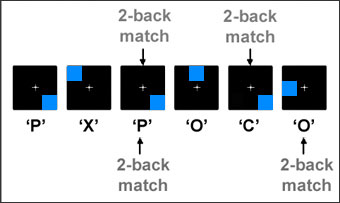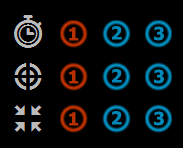Dual N-Back Training Options
Here you choose the type of n-back training you want to do.
‘Standard’ is the original Jaeggi et al (2009) dual n-back training task. It is an exact replica of this task that was shown to result in substantial gains in fluid intelligence after 19 sessions of training. (Reference here).
‘2nd Gen’ (2G) is the second generation n-back game incorporating more advanced, flexible and effective training principles including speed and variability of stimulus presentation, accuracy level for going up or down n-back levels, and the amount of ‘interference’ while training that has been shown to be critical for training fluid intelligence.
Both Standard and 2G training programs come with the money-back IQ and working memory increase guarantees.
What Do You Do In Standard N-Back Training?
The Dual Training Mode works in exactly the same way as in either Visual Training Mode or Audio Training Mode, starting with an ‘n-back’ = 1. The difference is that you now have to keep track of not just one sensory modality but two – simultaneously! At the same time as the square moves from location to location, you hear phonologically distinct letters. You must press the ‘F’ key if there is a visual match and the ‘L’ key if there is an audio (letter) match. If there is a match for both at the same time, you must press both the ‘F’ key and the ‘L’ key together. In the diagram below for the next n-back level up – a 2-back – there are 2 spatial (square) matches and 2 verbal (letter) matches in 6 moves.

If you get 90% correct or more in a block of 20 moves for both the spatial task (changing square), and the audio task, the memory ‘n-back’ gap for the next set of 20 moves increases to a ‘3-back’. If you get 70% or less in either visual or audio, the gap decreases to a ‘1-back’ for the next 20 moves (For a 1-back, you simply have to remember the previous location or letter in the series.) Otherwise the n-back level stays the same.
After each 10 block training session a window will appear giving you graphical feedback on how well you have done, as described above. Close the graph, and click on the ‘N=x’ arrow button (that indicates your current n-back level) to take you to the Session window. You can check out your performance stats here.
Your Aim: Increase Your N-Back Level!
Your aim over the 40 10-block sessions of of training – spaced out over a month (31 days) – is to increase your n-back level – a measure of your working memory capacity. The n-back gap could increase all the way to a 5-back or beyond as the working memory training takes effect. With more working memory capacity, you have effectively more ‘RAM power’ in your brain, and your intelligence will increase.
Leaderboard
You can see how you are performing relative to other i3 users in the Leaderboard (Hall of Fame’) tables which are displayed after each Session of training, and which you can access any time by clicking on the graph icon in the Session window.
What Do You Do In 2G N-Back Training?
2G dual n-back training starts with standard dual n-back as it’s default setting, but it allows for increasing the difficulty level on 3 different parameters, each of which is known to improve the effectiveness of cognitive training.
 If you are doing dual n-back training (not single n-back practice training), you can select difficulty levels (1-3) of our 3 second generation n-back options here. With higher settings you can potentially get more points for your 2G score, but the training task becomes more challenging. For this reason, you may also LOSE more points! The clock is for speed and variability of the stimulus presentation rate. The bulls-eye is for the level of accuracy you need to maintain or go up an n-back level. The distractors is for the amount of information in the task that actively distracts you from finding the correct matches and performing accurately in the dual n-back. This is the interference level of the task. The default values are 1 for each parameter. At the start of each Session and between every block of training, you can set the 3 levels you want to train at. Each time you go up an N-Back level, the levels on the three training parameters all reset to 1.
If you are doing dual n-back training (not single n-back practice training), you can select difficulty levels (1-3) of our 3 second generation n-back options here. With higher settings you can potentially get more points for your 2G score, but the training task becomes more challenging. For this reason, you may also LOSE more points! The clock is for speed and variability of the stimulus presentation rate. The bulls-eye is for the level of accuracy you need to maintain or go up an n-back level. The distractors is for the amount of information in the task that actively distracts you from finding the correct matches and performing accurately in the dual n-back. This is the interference level of the task. The default values are 1 for each parameter. At the start of each Session and between every block of training, you can set the 3 levels you want to train at. Each time you go up an N-Back level, the levels on the three training parameters all reset to 1.
[box]The science of 2G training is based on 4 advances in n-back training: interference control, speed/variability, n-back accuracy and capacity-strategy training (click for detailed information and references). These 2G training options significantly improve n-back effectiveness.[/box]
Your Aim: Increase Your 2G Score!
Your aim is to get as high a 2G score as you can over the 20-40 Sessions of training. The scoring is as follows:
 Speed and Variability
Speed and Variability
Level A. 3 seconds interval (1 point)
Level B. Random inter-stimulus interval between 3 seconds and 1.5 seconds (2 points)
Level C. Random inter-stimulus interval between 1.5 seconds and 0.75 seconds (3 points)
The points are also scaled up or down depending on the n-back level – the higher the n-back level you are on, the more points you get.
 Accuracy
Accuracy
Level A. 75 / 85% (1 point)
Level B. 85 / 95% (2 points)
Level C. 95 / 100% (3 points)
The points are also scaled up or down depending on the n-back level – the higher the n-back level you are on, the more points you get.
 Interference
Interference
Level A. % distractors – 15% (1 point)
Level B. % distractors – 20-40% (2 points)
Level C. % distractors – 50-70% (3 points)
The points are also scaled up or down depending on the n-back level – the higher the n-back level you are on, the more points you get.
It is the interference level that is most beneficial to increasing your IQ and fluid intelligence. The higher the level of interference you set here, the more you benefit in raising your IQ level.


